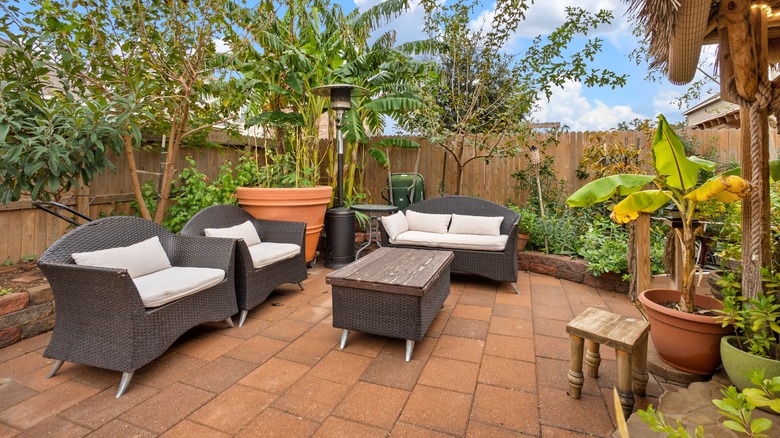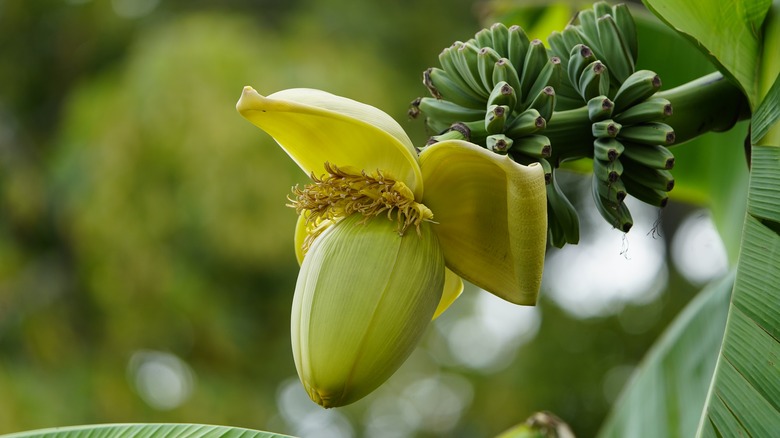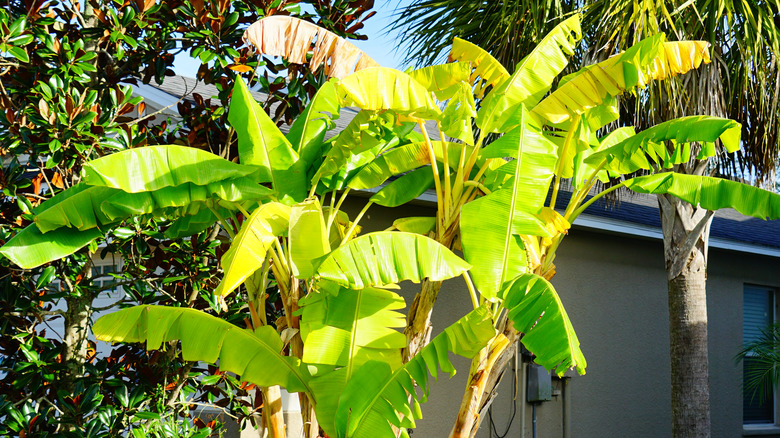Grow This Fruit Tree To Bring Tropical Vibes To Your Patio This Summer
Transport yourself to the tropics this summer without leaving your patio. How, you ask? By planting a lush and leafy banana tree. The Japanese banana tree, or Musa basjoo, is native to the Ryukyu Islands and looks like it belongs in the rainforest, thanks to its massive green leaves, yellow flowers, and tiny fruit. But, it will grow happily in your backyard and is relatively low maintenance. It tolerates freezing winters outdoors and can also be transferred inside during the colder months, making it one of the best statement house plants to own if you don't have a green thumb.
If you want to transform your patio into an exotic oasis, this majestic banana tree is a must. Before you plant, it's important to know what you're in for. Although its needs are simple, its environment must be set up properly for it to thrive. When it's time to overwinter the tree, you must take several measures to keep it in good shape for the season. If you aren't an expert in the realm of tropical plants, don't sweat it because caring for the Musa basjoo is easier than you think.
How to grow a Japanese banana tree in your yard
You don't need to be a seasoned gardener to propagate a thriving banana tree. You will enjoy this plant's tropical vibe on your patio without working too hard to keep it happy and healthy. The Musa basjoo banana tree grows best in well-draining, nutrient-rich, semi-moist soil. To grow it in a container, you will need a well-draining potting soil mix kept consistently damp but never waterlogged. Use well-balanced fertilizer regularly during the warmer months only. This banana tree should be sheltered from the wind and receive six to eight hours of direct sun exposure. However, some partial shade throughout the day is okay. The plant also loves humidity, so place it near a water feature or give it an occasional misting.
Caring for this plant during its growing season is relatively simple — it's the winter care that can be a bit tricky. If your banana tree is growing in the ground, prune it until it's no taller than 2 feet. To keep your banana tree safe from frost, swaddle it in burlap, bubble wrap, or plastic to shelter the stems and mulch around it thoroughly to protect the roots. If you are growing a potted banana tree, move it inside in the fall and keep it as a trendy big-leaf houseplant, or store it in a cool area of your garage and water it minimally until the spring.
Important things to know about your Musa basjoo banana plant
Before adding this beautiful tree to your outdoor plant collection, consider a few factors. If you're hoping to harvest fruit from your tree, this particular variety is not the most fitting choice. Japanese banana trees do produce bananas, but they are small, seedy, and relatively inedible. It could take up to two years for the plant to produce fruit; when it does, the pseudo-stem (or trunk) dies, but a new one will grow in its place. Thanks to its fruit and flowers, the Musa basjoo attracts hungry visitors like grasshoppers, borers, and root nematodes, which are known to attack this tree by chewing into its roots and leaves. The plant is also susceptible to spider mites, mealybugs, and aphids when grown indoors as well as outdoors.
This plant is beloved by gardeners for its incredible paddle-shaped leaves and creamy yellow flowers, adding a burst of exotic beauty to outdoor spaces. A benefit of this plant is that it is fast-growing and can reach heights of up to 15 feet in three years. Watch out for signs of anthracnose or mosaic virus, which the Japanese banana tree is susceptible to. Most of the time, the early signs of mosaic virus are indicated by yellow mosaic patterns on the leaves, while anthracnose causes black lesions on the fruits as they develop. Now that you know the ins and outs, you're ready to give this tropical plant a good home.


